
Freight transportation company Union Pacific (NYSE: UNP) met Wall Street’s revenue expectations in Q4 CY2024, but sales were flat year on year at $6.12 billion. Its GAAP profit of $2.91 per share was 4.4% above analysts’ consensus estimates.
Is now the time to buy Union Pacific? Find out by accessing our full research report, it’s free.
Union Pacific (UNP) Q4 CY2024 Highlights:
- Revenue: $6.12 billion vs analyst estimates of $6.15 billion (flat year on year, in line)
- Adjusted EPS: $2.91 vs analyst estimates of $2.79 (4.4% beat)
- Adjusted EBITDA: $3.13 billion vs analyst estimates of $3.09 billion (51.2% margin, 1.3% beat)
- Operating Margin: 41.3%, up from 39.1% in the same quarter last year
- Free Cash Flow Margin: 28.4%, up from 9.5% in the same quarter last year
- Market Capitalization: $143 billion
“Our strong fourth quarter results represent a great capstone to a very successful year for Union Pacific,” said Jim Vena, Union Pacific Chief Executive Officer.
Company Overview
Part of the transcontinental railroad project, Union Pacific (NYSE: UNP) is a freight transportation company that operates a major railroad network.
Rail Transportation
The growth of e-commerce and global trade continues to drive demand for shipping services, presenting opportunities for rail transportation companies. While moving large volumes by rail can be highly cost-efficient for customers compared to air and ground transport, this mode of transportation results in slower delivery times, presenting a trade off. To improve transit times, the industry continues to invest in digitization to optimize fleets, loads, and even braking systems. However, rail transportation companies are still at the whim of economic cycles. Consumer spending, for example, can greatly impact the demand for these companies’ offerings while fuel costs can influence profit margins.
Sales Growth
A company’s long-term performance is an indicator of its overall quality. While any business can experience short-term success, top-performing ones enjoy sustained growth for years. Regrettably, Union Pacific’s sales grew at a sluggish 2.2% compounded annual growth rate over the last five years. This fell short of our benchmarks and is a poor baseline for our analysis.
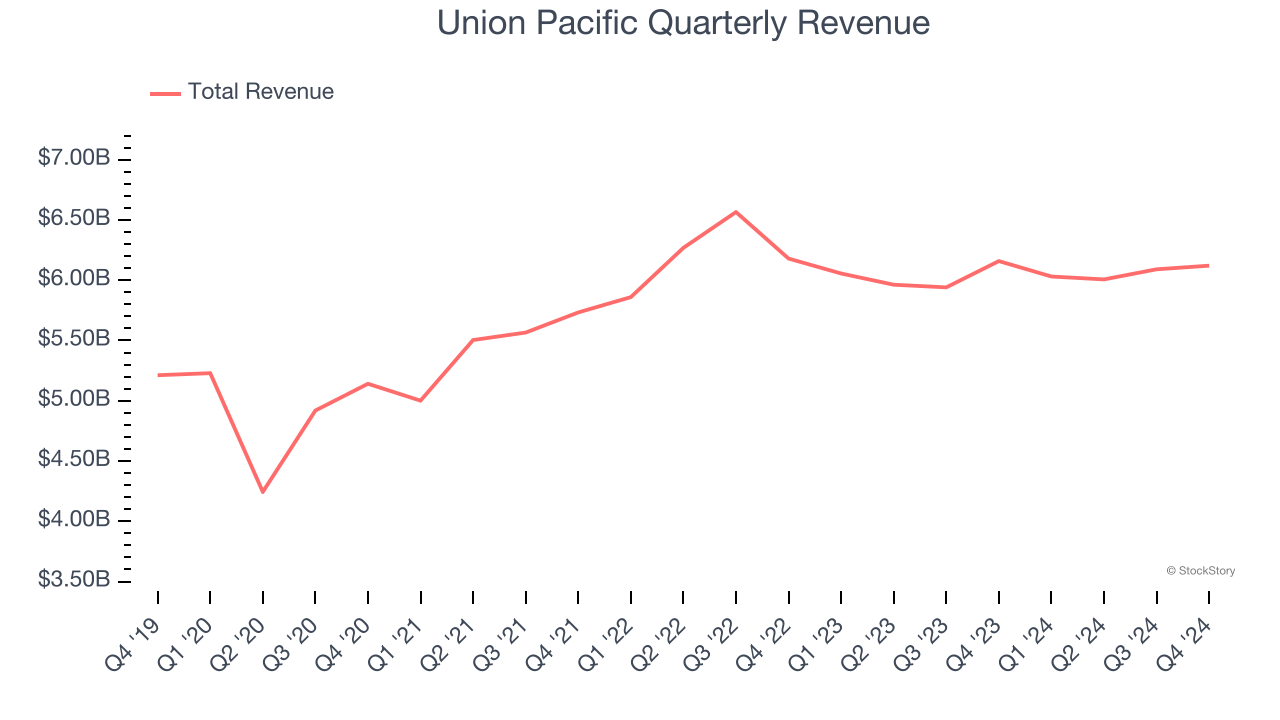
We at StockStory place the most emphasis on long-term growth, but within industrials, a half-decade historical view may miss cycles, industry trends, or a company capitalizing on catalysts such as a new contract win or a successful product line. Union Pacific’s history shows it grew in the past but relinquished its gains over the last two years, as its revenue fell by 1.3% annually. Union Pacific isn’t alone in its struggles as the Rail Transportation industry experienced a cyclical downturn, with many similar businesses observing lower sales at this time. 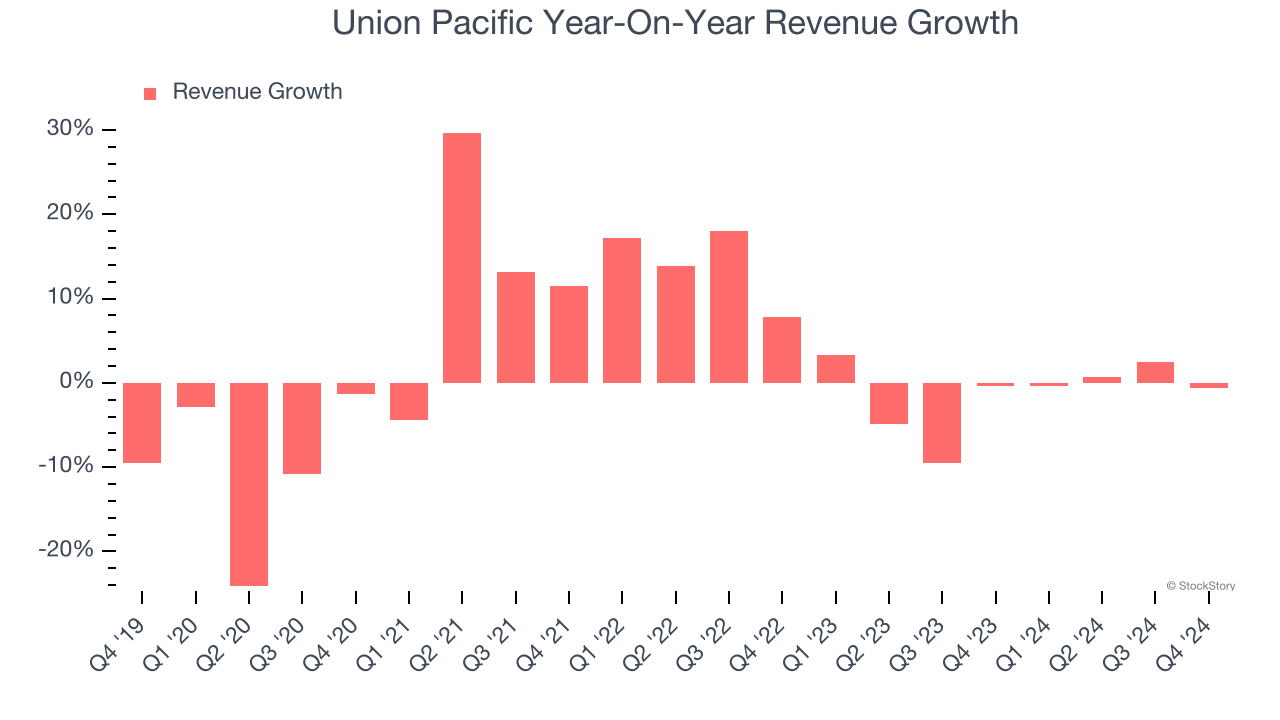
This quarter, Union Pacific’s $6.12 billion of revenue was flat year on year and in line with Wall Street’s estimates.
Looking ahead, sell-side analysts expect revenue to grow 3.5% over the next 12 months. Although this projection implies its newer products and services will fuel better top-line performance, it is still below average for the sector.
Software is eating the world and there is virtually no industry left that has been untouched by it. That drives increasing demand for tools helping software developers do their jobs, whether it be monitoring critical cloud infrastructure, integrating audio and video functionality, or ensuring smooth content streaming. Click here to access a free report on our 3 favorite stocks to play this generational megatrend.
Operating Margin
Union Pacific has been a well-oiled machine over the last five years. It demonstrated elite profitability for an industrials business, boasting an average operating margin of 40%. This result isn’t surprising as its high gross margin gives it a favorable starting point.
Analyzing the trend in its profitability, Union Pacific’s operating margin might have seen some fluctuations but has generally stayed the same over the last five years, highlighting the long-term consistency of its business.
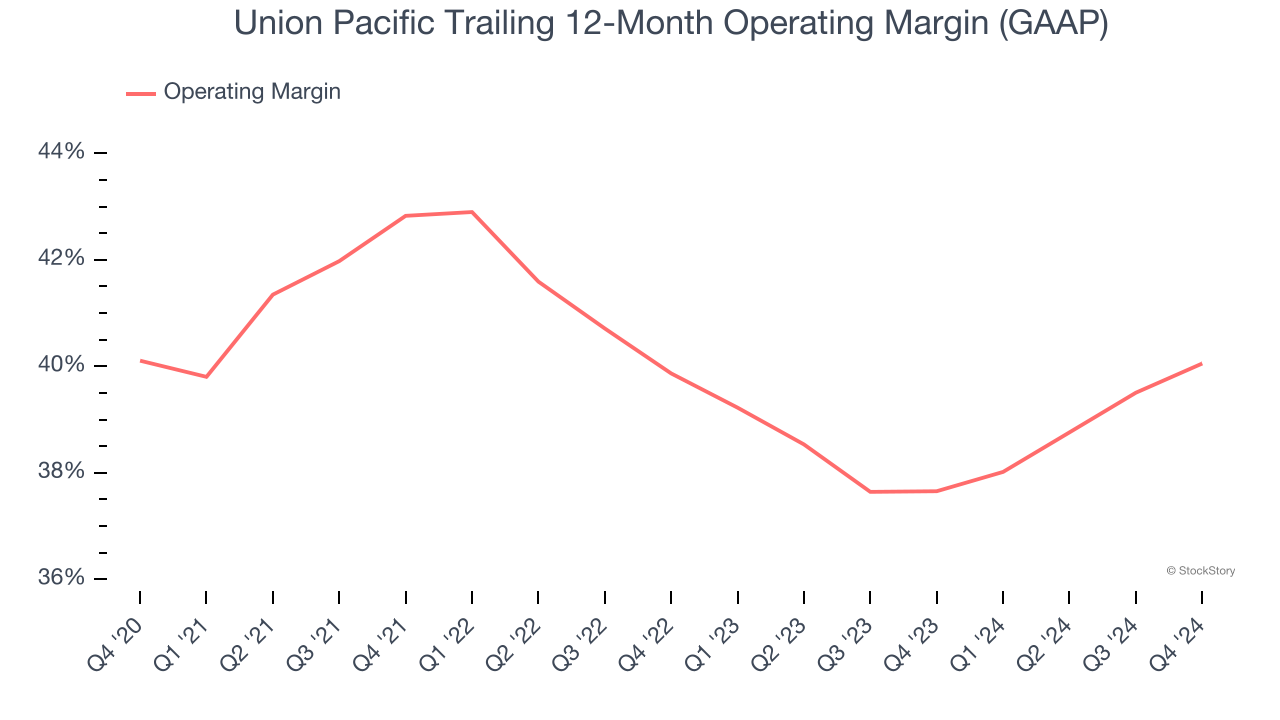
This quarter, Union Pacific generated an operating profit margin of 41.3%, up 2.2 percentage points year on year. The increase was encouraging, and since its operating margin rose more than its gross margin, we can infer it was recently more efficient with expenses such as marketing, R&D, and administrative overhead.
Earnings Per Share
Revenue trends explain a company’s historical growth, but the long-term change in earnings per share (EPS) points to the profitability of that growth – for example, a company could inflate its sales through excessive spending on advertising and promotions.
Union Pacific’s EPS grew at an unimpressive 5.7% compounded annual growth rate over the last five years. This performance was better than its 2.2% annualized revenue growth but doesn’t tell us much about its business quality because its operating margin didn’t expand.
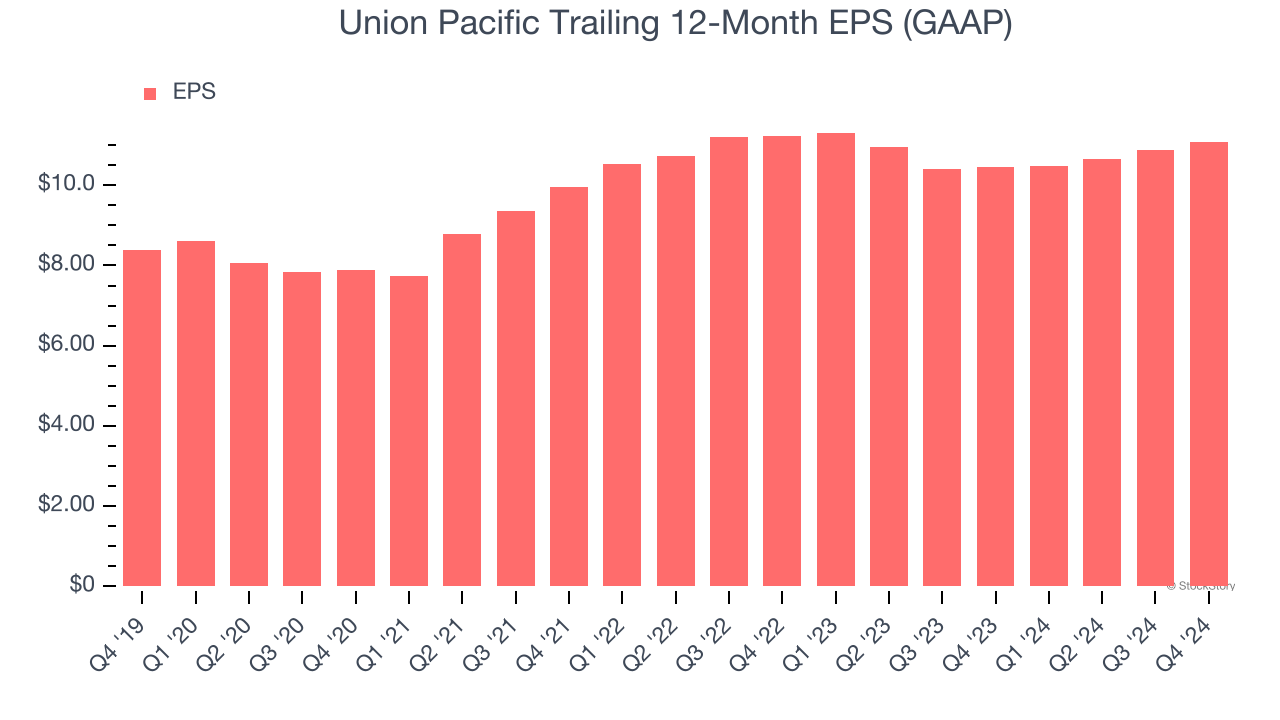
We can take a deeper look into Union Pacific’s earnings to better understand the drivers of its performance. A five-year view shows that Union Pacific has repurchased its stock, shrinking its share count by 12.9%. This tells us its EPS outperformed its revenue not because of increased operational efficiency but financial engineering, as buybacks boost per share earnings. 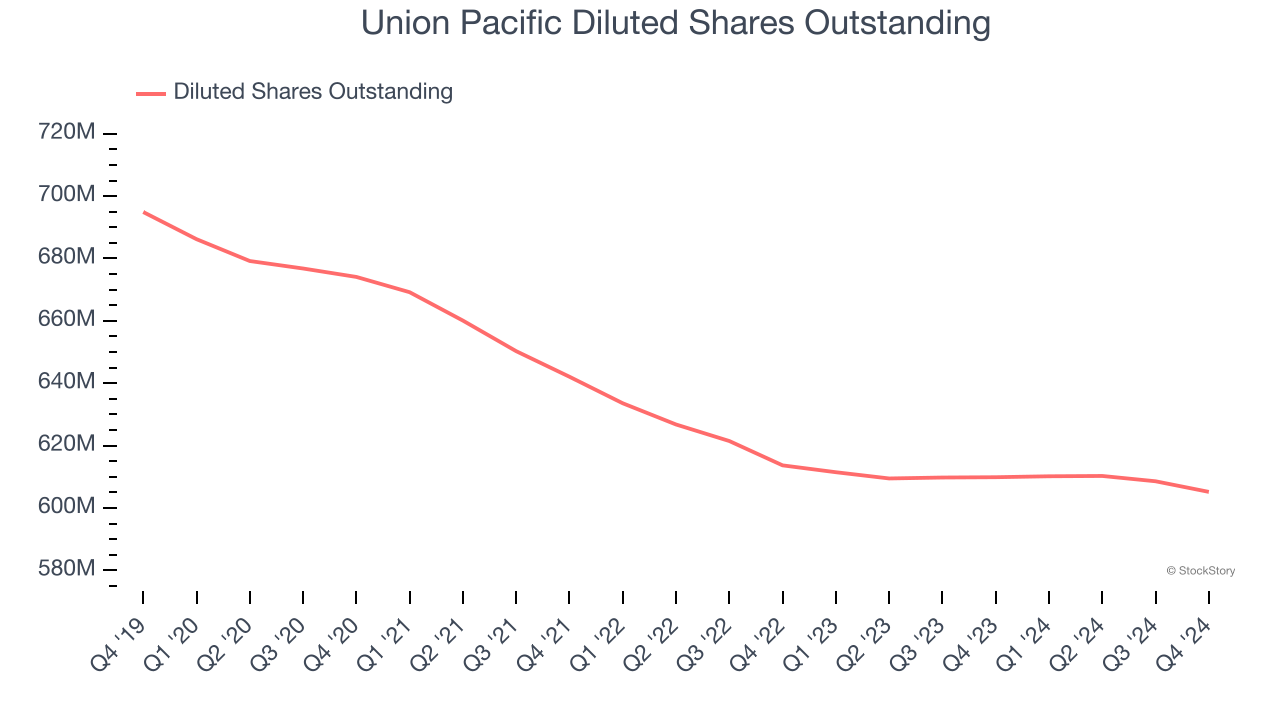
Like with revenue, we analyze EPS over a more recent period because it can provide insight into an emerging theme or development for the business.
For Union Pacific, EPS didn’t budge over the last two years, a regression from its five-year trend. We hope it can revert to earnings growth in the coming years.
In Q4, Union Pacific reported EPS at $2.91, up from $2.71 in the same quarter last year. This print beat analysts’ estimates by 4.4%. Over the next 12 months, Wall Street expects Union Pacific’s full-year EPS of $11.09 to grow 7.8%.
Key Takeaways from Union Pacific’s Q4 Results
It was encouraging to see Union Pacific beat analysts’ EPS and EBITDA expectations this quarter while reporting in-line revenue. Its 2025 outlook was also unchanged from the guidance shared on its Investor Day (September 19, 2024). Zooming out, we think this was a decent quarter featuring some areas of strength. The stock traded up 4.5% to $246.20 immediately after reporting.
Big picture, is Union Pacific a buy here and now? The latest quarter does matter, but not nearly as much as longer-term fundamentals and valuation, when deciding if the stock is a buy. We cover that in our actionable full research report which you can read here, it’s free.






